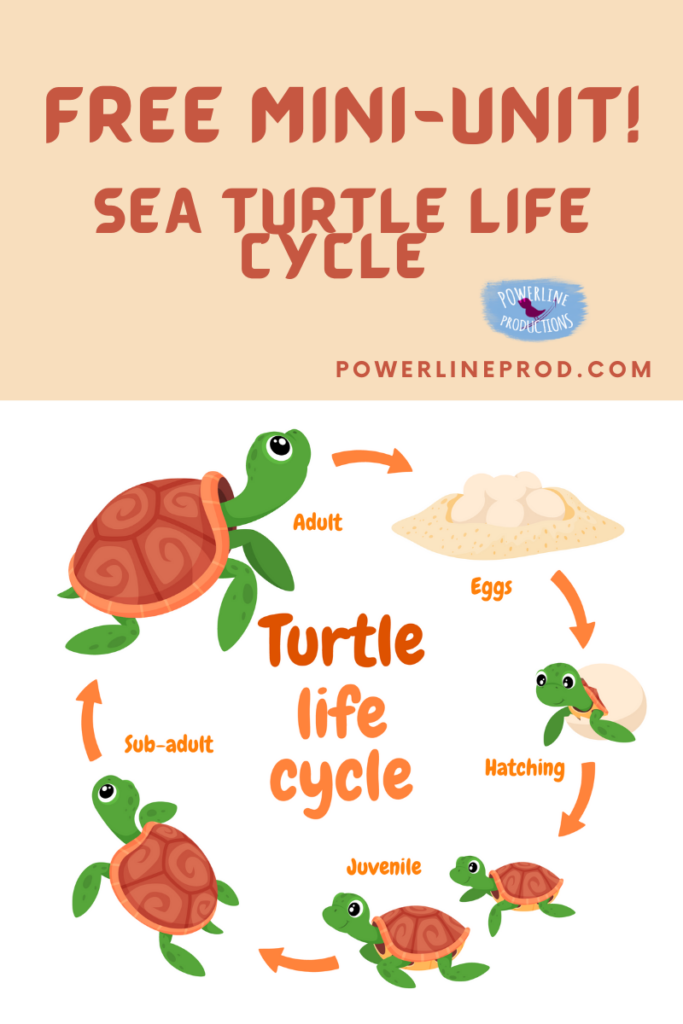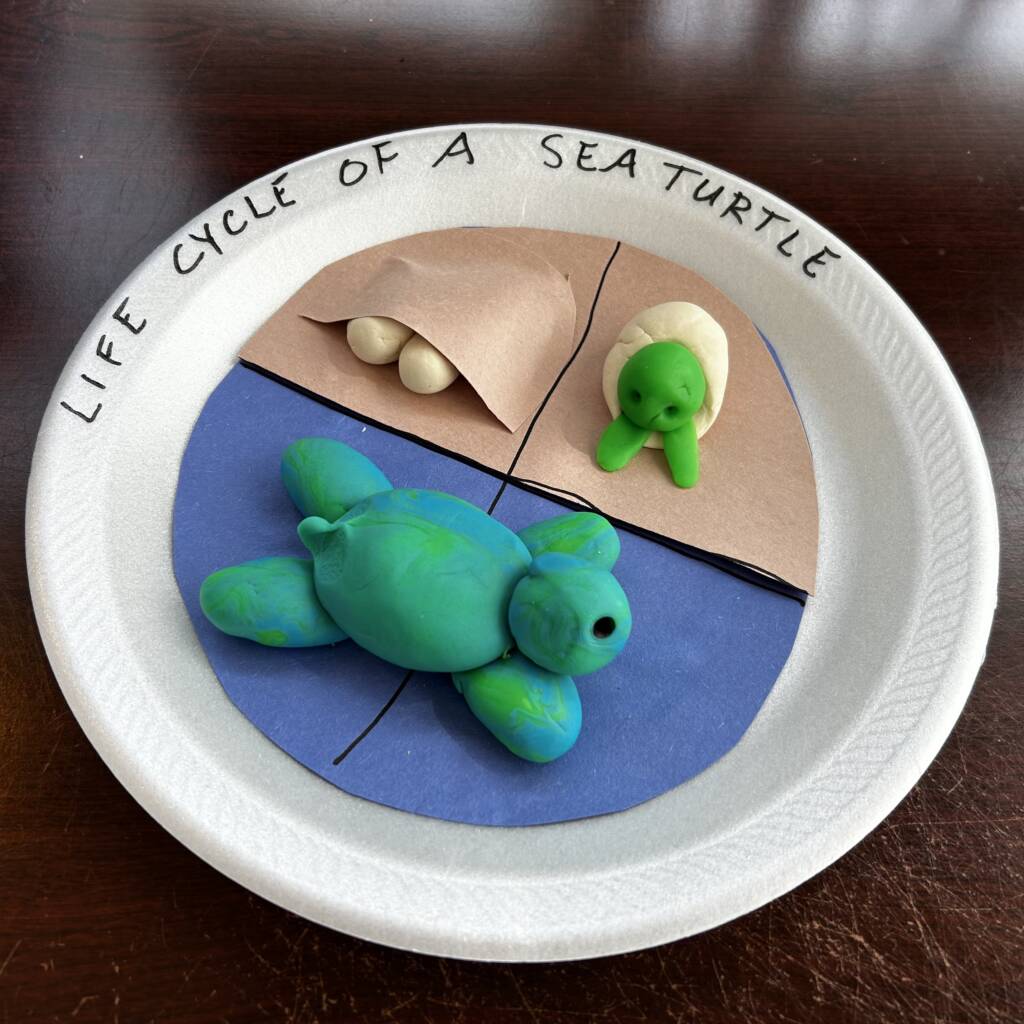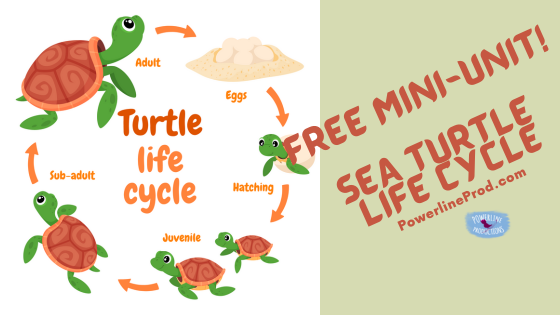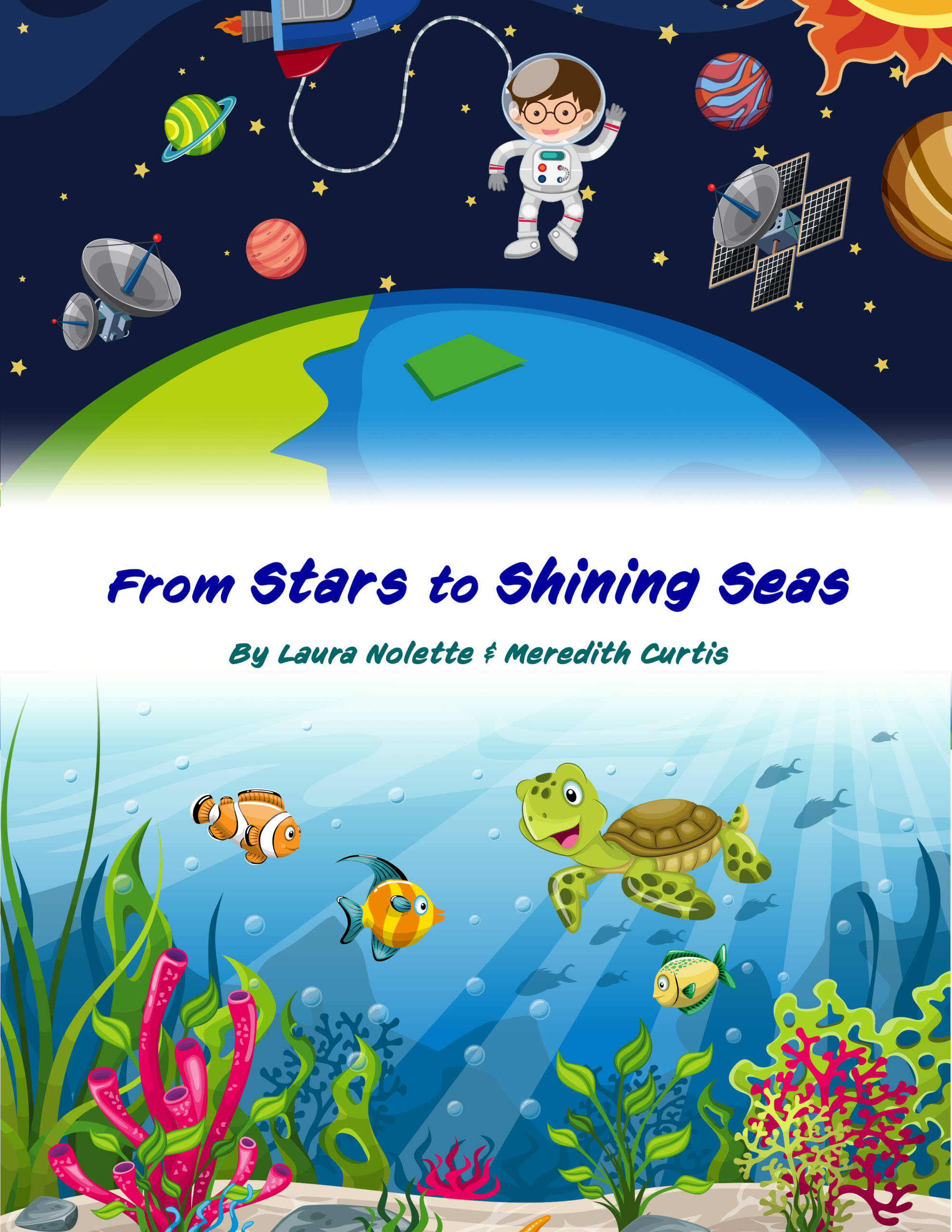Are you ready to learn about the sea turtle life cycle? This engaging mini-unit has interesting facts, a fun craft, and some videos you’ll love!
In our state (Florida) sea turtles hatch in the late summer/fall months. We’ve seen sea turtle nests on our walks on the beach this summer. Everyone is careful when sea turtles are hatching to keep lights off at night so it doesn’t confuse the sweet little animals. Do you live near a beach? When do sea turtles hatch where you live?
Onward to the our mini-unit!
Start with a fun video. This is the sea turtle scene from Finding Nemo.
Amazing Swimming Reptiles
Sea turtle can be longer than six feet and weigh more than 1,000 pounds. They are often called gentle giants. Turtles have four legs, a head, and a tail all sticking out of a large dome shaped shell. The shell is called a carapace. The carapace is part of the turtle’s skeleton so they cannot remove it.
Sea turtles are different than freshwater turtles in a couple of special ways. Their legs are flippers so they can swim well. They cannot pull their head and flippers into their shell the way freshwater turtles can. Sea turtles also have a salt gland that removes the extra salt from their bodies. Too much salt can kill a creature. That’s why you should not drink saltwater. Sea creatures all have a way to remove the extra salt from their bodies.
There are several different kinds of sea turtles. Most of them can be seen in the oceans around the United States. These great creatures spend most of their lives travelling the oceans all over the world.
Reptiles breathe air with lungs. That means turtles need to come out of the water to breathe. At least part of their bodies needs to. Their nostrils are on the top of their heads so they can tip up their head and breathe while keeping all the rest of their body hiding under the water.

For a creature that swims across huge, deep oceans this can be a problem. God prepared sea turtle for that life. He gave them the ability to hold their breathe for hours. He also made them to float. But how do they sleep? Let me explain.
When you and I want to float we have to stretch out our bodies flat and make ourselves float but turtles are just made to float. When turtles are staying in shallow waters there are a lot of predators around, so they must hide to sleep. They bury themselves under heavy rocks to keep from floating up and keep from being seen. They can only sleep for about an hour like this before they need to go back up to the surface for air. When turtles are in the deep, open ocean, they just float with their nostrils above the water to breathe while they sleep.
Sea Turtle Life Cycle: Nesting
Turtles swim all over the oceans to find food and to reproduce. Some turtles are herbivores and need to go to where the plants are growing. Other turtles are omnivores and will eat plants and animals alike. Some turtles love to eat jellyfish. All these food sources are found in different parts of the oceans, so the turtles follow the food. They can dive very deep in the ocean and swim very far but they must always return to land to lay eggs and make baby turtles.
When baby turtles are born, they must be somewhere there is air for them to breathe. That means they must be born on the land. The mommy turtles swim to a beach, then struggle across the hard sand to the soft dry sand and dig a hole. They bury their eggs in that hole and hope that the babies make it back to the ocean safely. Where I live in Florida the beaches are often marked with “Do Not Disturb” signs around turtle nests. We don’t want any baby turtles killed by somebody walking or driving over their nest.
Sea Turtle Life Cycle: Hatchlings to the Sea
When the babies hatch, they dig themselves out of the sandy nest then they work their way across the beach and into the surf. They look very much like their parents. They already know where to go and how to swim. It’s amazing that God prepared such tiny creatures for a grand adventure on their first day of life.
Sea Turtle Life Cycle Craft
Would you like to make a model of the sea turtle life cycle? What a great way to remember! Let’s make a model of a turtle’s life cycle out of playdough

Supplies:
- Paper Plate
- Blue Construction Paper
- Sand Construction Paper
- Glue
- Green, Blue, and White Play Dough
- Tiny Black Beads (Optional)
- Black Crayon or Marker
Cut the blue and the sand-colored construction paper into a circle the size to fit in the bottom of the paper plate. Cut the sand-colored circle in half. Glue the sand-colored semi-circle on the blue circle and glue it on the plate. Use the black crayon or marker to draw a line across the two semi-circles. Now you have four sections, two blue and two sand-colored. Form an egg shape with some of the white play dough. Place it on one sand section. Cut the remaining semi-circle of sand-colored paper into a smaller semi-circle and lay it across half the egg, like a blanket. Glue the edges down to form a turtle nest. Form another egg out of white play dough then flatten one side of it. Shape some of the green playdough into a turtle head and two front flippers. You can use the beads to make eyes for your baby turtle. Press the head and flippers in place on the flat part of the egg so that it looks like the rest of the turtle’s body is still in the other half of the egg. Place this in the second sand-colored section. Using more of the green play dough, form a small sea turtle and place it in the next section on the plate. This is the blue water because our little turtle has made it out to sea. Use some blue green play dough to form a larger, full-grown turtle for the last section. Write egg, hatchling, juvenile, and adult in the correction sections.
Learning More About Sea Turtles
Resource to Learn STEM the Fun Way!
This mini-unit was taken from lesson #34 of From Stars to Shining Seas, our exciting elementary science textbook/unit study – a years’ worth of hands-on science learning fun! Starting with space, moving to earth science, and ending with oceanography, this is an amazing year of learning science the fun way!
You can purchase From Stars to Shining Seas at PowerlineProd. Purchase in print at Amazon.
I hope you’ve enjoyed our mini unit. Until next time, Happy Homeschooling!
Warmly,
Meredith Curtis



Add Comment